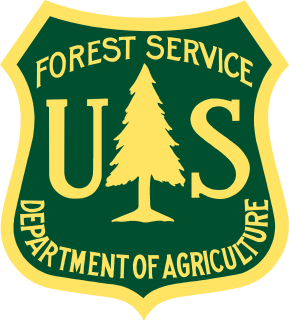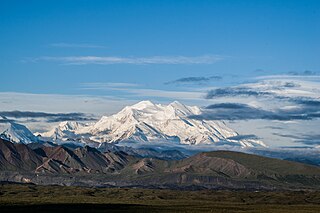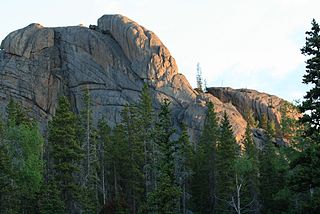
The United States Forest Service (USFS) is an agency of the U.S. Department of Agriculture that administers the nation's 154 national forests and 20 national grasslands. The Forest Service manages 193 million acres (780,000 km2) of land. Major divisions of the agency include the Chief's Office, National Forest System, State and Private Forestry, Business Operations, and Research and Development. The agency manages about 25% of federal lands and is the only major national land management agency not part of the U.S. Department of the Interior, which manages the National Park Service, the U.S. Fish and Wildlife Service, and the Bureau of Land Management.

The Tongass National Forest in Southeast Alaska is the largest U.S. National Forest at 16.7 million acres. Most of its area is temperate rain forest and is remote enough to be home to many species of endangered and rare flora and fauna. The Tongass, which is managed by the United States Forest Service, encompasses islands of the Alexander Archipelago, fjords and glaciers, and peaks of the Coast Mountains. An international border with Canada runs along the crest of the Boundary Ranges of the Coast Mountains. The forest is administered from Forest Service offices in Ketchikan. There are local ranger district offices located in Craig, Hoonah, Juneau, Ketchikan, Petersburg, Sitka, Thorne Bay, Wrangell, and Yakutat.

The Bob Marshall Wilderness Area is a congressionally-designated wilderness area located in Western Montana region of the United States. It is named after Bob Marshall (1901–1939), an early forester in the federal government, conservationist, and co-founder of The Wilderness Society. In the 1930s while working for the Forest Service, Marshall was largely responsible for designation of large areas to be preserved as roadless within lands administered by the Forest Service; he achieved this through promulgation of various regulations. Formally designated in 1964, the Bob Marshall Wilderness extends for 60 miles (95 km) along the Continental Divide and consists of 1,009,356 acres (4,085 km²).

The Wilderness Act of 1964 was written by Howard Zahniser of The Wilderness Society. It created the legal definition of wilderness in the United States, and protected 9.1 million acres (37,000 km²) of federal land. The result of a long effort to protect federal wilderness and to create a formal mechanism for designating wilderness, the Wilderness Act was signed into law by President Lyndon B. Johnson on September 3, 1964 after over sixty drafts and eight years of work.

Michael P. Dombeck is an American conservationist, educator, scientist, and outdoorsman. He served as Acting Director of the Bureau of Land Management from 1994–1997 and was the 14th Chief of the United States Forest Service from 1997 to 2001. Dombeck also served as UW System Fellow and Professor of Global Conservation at the University of Wisconsin-Stevens Point from 2001 to 2010. He has been the Executive Director of the David Smith Post-Doctoral Conservation Research Fellowship since 2005.

The National Wilderness Preservation System (NWPS) of the United States protects federally managed wilderness areas designated for preservation in their natural condition. Activity on formally designated wilderness areas is coordinated by the National Wilderness Preservation System. Wilderness areas are managed by four federal land management agencies: the National Park Service, the U.S. Forest Service, the U.S. Fish and Wildlife Service, and the Bureau of Land Management.

Roadless area conservation is a conservation policy limiting road construction and the resulting environmental impact on designated areas of public land. In the United States, roadless area conservation has centered on U.S. Forest Service areas known as inventoried roadless areas. The most significant effort to support the conservation of these efforts was the Forest Service 2001 Roadless Area Conservation Rule.

The California Wilderness Act of 1984 is a federal law, passed by the United States Congress on September 28, 1984, that authorized the addition of over 3 million acres (12,000 km2) within the state of California to the National Wilderness Preservation System. Conservation activist George Whitmore later credited the Act with establishing "the longest stretch of de facto wilderness in the lower 48 states."

The Dardanelles and Freel Roadless Areas are located 7 miles (11 km) and 3 miles (4.8 km), respectively, south of Lake Tahoe, California, and both are managed by the Lake Tahoe Basin Management Unit of the US Forest Service.These areas are contiguous, separated only by the corridor of highway 89. The historic Hawley Grade, an immigrant wagon road, now a hiking trail, is within the Dardanelles Roadless Area, as well as the watershed of Lake Tahoe's largest inflow, the Upper Truckee River.

The Rock Creek Roadless Area (B032) is located northwest of Buffalo, Wyoming, in the Bighorn National Forest. It comprises roughly 34,000 acres (140 km2) of forested timberlands, mountain parks, rugged canyons, and stunning rock formations. This area represents the entire spectrum of environments found in the Bighorn National Forest and encompasses prairie land to high alpine peaks. This roadless area is the source of the north, middle, and south forks of Rock Creek, Balm of Gilead Creek, Pheasant Creek, and Ditch Creek. The area is flanked on the eastern side by the Bud Love Big Game Winter Range and the HF Bar Ranch Historic District. On the southern side the roadless area is surrounded by the Paradise Guest Ranch. The roadless area is home to elk, moose, mountain lion, pine marten, blue grouse, ruffed grouse, and raptors. The Rock Creek area is the largest area of quality elk security habitat outside of the Cloud Peak Wilderness Area and would provide an important corridor from the high country to the Bud Love Habitat Management Unit. The Rock Creek roadless area is dominated by lodgepole pine, some ponderosa, and aspen stands with low-growing juniper in the undergrowth. The area has not been opened to roads due to the ruggedness of the landscape and the high costs of implementation.

The Wyoming Wilderness Association is an American non-governmental, not-for-profit working to protect Wyoming's wild public lands through wilderness designations. WWA was founded in 1979 by a group of wilderness advocates and outdoors people who envisioned the first Wyoming Wilderness Act. In 1984, the passage of the Wyoming Wilderness Act brought to all Americans the permanent protection of an additional 1.1 million acres of ecologically diverse, wild country in Wyoming. WWA was instrumental in passing the act by educating and train activists on a grassroots level. In 2003, WWA was reborn with a new opportunity to protect additional wild watersheds, intact ecosystems, old-growth forests, important wildlife habitat, and wildlife migration corridors – wild landscapes that truly deserve lasting protection as wilderness. As of 2012, the organization has over 700 members with offices in Sheridan, Buffalo, Lander, Dubois, and Jackson Wyoming.

Browns Canyon National Monument is a 21,586 acres (87 km2) national monument in Chaffee County, Colorado, that was designated as such by President Barack Obama under the Antiquities Act on February 19, 2015. The site will be centered along the Arkansas River between Buena Vista and Salida. Browns Canyon is the most popular destination for whitewater rafting in the country, and is also known for its fishing and hiking. The monument will provide habitat protection for bighorn sheep, peregrine falcons, elk, and golden eagles.
The Southeast Alaska Conservation Council (SEACC) is a non-profit organization that focuses on protecting the lands and waters of Southeast Alaska. They promote conservation and advocate for sustainable natural resource management. SEACC is located in Alaska's capital, Juneau. The environmental organization focuses specifically on concerns in the Southeast region of Alaska, including: the Panhandle, the Tongass National Forest and the Inside Passage.
James River Face Wilderness Addition is a wildland in the George Washington and Jefferson National Forests of western Virginia that has been recognized by the Wilderness Society as a special place worthy of protection from logging and road construction. Adjacent to the James River Face Wilderness, it extends the wildland opportunities of the wilderness on the east to the Jefferson National Forest boundary. The area, managed for bear, has hardwood forests with ages between 60 and almost 100 years.
Cove Mountain is a wildland in the George Washington and Jefferson National Forests of western Virginia that has been recognized by the Wilderness Society as a special place worthy of protection from logging and road construction.
Roaring Branch, a wildland in the George Washington and Jefferson National Forests of western Virginia, has been recognized by the Wilderness Society as a special place worthy of protection from logging and road construction. The Wilderness Society has designated the area as a "Mountain Treasure".
Little Stony Creek, a wildland in the George Washington and Jefferson National Forests of western Virginia, has been recognized by the Wilderness Society as a special place worthy of protection from logging and road construction. The Wilderness Society has designated the area as a "Mountain Treasure".

Laurel Fork , a wildland in the George Washington and Jefferson National Forests of western Virginia, has been recognized by the Wilderness Society as a special place worthy of protection from logging and road construction. The Wilderness Society has designated the area as a “Mountain Treasure”.
Patterson Mountain, a wildland in the George Washington and Jefferson National Forests of western Virginia, has been recognized by the Wilderness Society as a special place worthy of protection from logging and road construction. The Wilderness Society has designated the area as a "Mountain Treasure".
Dismal Creek, a wildland in the George Washington and Jefferson National Forests of western Virginia, has been recognized by the Wilderness Society as a special place worthy of protection from logging and road construction. The Wilderness Society has designated the area as a "Mountain Treasure".












